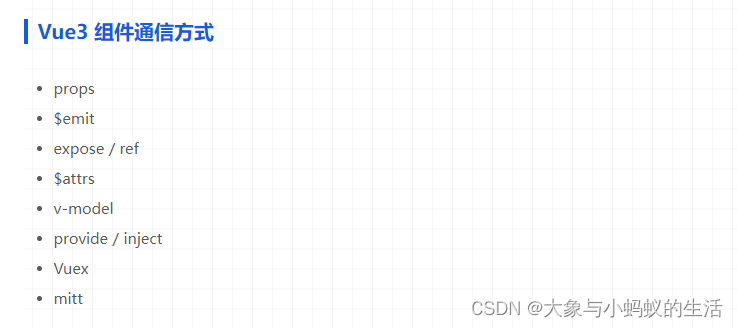
1. props
用 props 传数据给子组件有两种方法,如下
1、混合写法
// Parent.vue 传送
<child :msg1="msg1" :msg2="msg2"></child>
<script>
import child from "./child.vue"
import { ref, reactive } from "vue"
export default {
data(){
return {
msg1:"这是传级子组件的信息1"
}
},
setup(){
// 创建一个响应式数据
// 写法一 适用于基础类型 ref 还有其他用处,下面章节有介绍
const msg2 = ref("这是传级子组件的信息2")
// 写法二 适用于复杂类型,如数组、对象
const msg2 = reactive(["这是传级子组件的信息2"])
return {
msg2
}
}
}
</script>
// Child.vue 接收
<script>
export default {
props: ["msg1", "msg2"],// 如果这行不写,下面就接收不到
setup(props) {
console.log(props) // { msg1:"这是传给子组件的信息1", msg2:"这是传给子组件的信息2" }
},
}
</script>
2、纯 Vue3 写法(语法糖)
// Parent.vue 传送
<child :msg2="msg2"></child>
<script setup>
import child from "./child.vue"
import { ref, reactive } from "vue"
const msg2 = ref("这是传给子组件的信息2")
// 或者复杂类型
const msg2 = reactive(["这是传级子组件的信息2"])
</script>
// Child.vue 接收
<script setup>
// 不需要引入 直接使用
// import { defineProps } from "vue"
const props = defineProps({
// 写法一
msg2: String
// 写法二
msg2:{
type:String,
default:""
}
})
console.log(props) // { msg2:"这是传级子组件的信息2" }
</script>
注意
1.如果父组件是混合写法,子组件纯 Vue3 写法的话,是接收不到父组件里 data 的属性,只能接收到父组件里 setup 函数里传的属性
- 如果父组件是纯 Vue3 写法,子组件混合写法,可以通过 props 接收到 data 和 setup 函数里的属性,但是子组件要是在 setup 里接收,同样只能接收到父组件中 setup 函数里的属性,接收不到 data 里的属性
- 官方也说了,既然用了 3,就不要写 2 了,所以不推荐混合写法。下面的例子,一律只用纯 Vue3 的写法,就不写混合写法了
2. $emit
// Child.vue 派发
<template>
// 写法一
<button @click="emit('myClick')">按钮</buttom>
// 写法二
<button @click="handleClick">按钮</buttom>
</template>
<script setup>
// 方法一 适用于Vue3.2版本 不需要引入
// import { defineEmits } from "vue"
// 对应写法一
const emit = defineEmits(["myClick","myClick2"])
// 对应写法二
const handleClick = ()=>{
emit("myClick", "这是发送给父组件的信息")
}
// 方法二 不适用于 Vue3.2版本,该版本 useContext()已废弃
import { useContext } from "vue"
const { emit } = useContext()
const handleClick = ()=>{
emit("myClick", "这是发送给父组件的信息")
}
</script>
// Parent.vue 响应
<template>
<child @myClick="onMyClick"></child>
</template>
<script setup>
import child from "./child.vue"
const onMyClick = (msg) => {
console.log(msg) // 这是父组件收到的信息
}
</script>
3. expose / ref
// Child.vue
<script setup>
// 方法一 不适用于Vue3.2版本,该版本 useContext()已废弃
import { useContext } from "vue"
const ctx = useContext()
// 对外暴露属性方法等都可以
ctx.expose({
childName: "这是子组件的属性",
someMethod(){
console.log("这是子组件的方法")
}
})
// 方法二 适用于Vue3.2版本, 不需要引入
// import { defineExpose } from "vue"
defineExpose({
childName: "这是子组件的属性",
someMethod(){
console.log("这是子组件的方法")
}
})
</script>
// Parent.vue 注意 ref="comp"
<template>
<child ref="comp"></child>
<button @click="handlerClick">按钮</button>
</template>
<script setup>
import child from "./child.vue"
import { ref } from "vue"
const comp = ref(null)
const handlerClick = () => {
console.log(comp.value.childName) // 获取子组件对外暴露的属性
comp.value.someMethod() // 调用子组件对外暴露的方法
}
</script>
4. attrs
attrs:包含父作用域里除 class 和 style 除外的非 props 属性集合
// Parent.vue 传送
<child :msg1="msg1" :msg2="msg2" title="3333"></child>
<script setup>
import child from "./child.vue"
import { ref, reactive } from "vue"
const msg1 = ref("1111")
const msg2 = ref("2222")
</script>
// Child.vue 接收
<script setup>
import { defineProps, useContext, useAttrs } from "vue"
// 3.2版本不需要引入 defineProps,直接用
const props = defineProps({
msg1: String
})
// 方法一 不适用于 Vue3.2版本,该版本 useContext()已废弃
const ctx = useContext()
// 如果没有用 props 接收 msg1 的话就是 { msg1: "1111", msg2:"2222", title: "3333" }
console.log(ctx.attrs) // { msg2:"2222", title: "3333" }
// 方法二 适用于 Vue3.2版本
const attrs = useAttrs()
console.log(attrs) // { msg2:"2222", title: "3333" }
</script>
5. v-model
// Parent.vue
<child v-model:key="key" v-model:value="value"></child>
<script setup>
import child from "./child.vue"
import { ref, reactive } from "vue"
const key = ref("1111")
const value = ref("2222")
</script>
// Child.vue
<template>
<button @click="handlerClick">按钮</button>
</template>
<script setup>
// 方法一 不适用于 Vue3.2版本,该版本 useContext()已废弃
import { useContext } from "vue"
const { emit } = useContext()
// 方法二 适用于 Vue3.2版本,不需要引入
// import { defineEmits } from "vue"
const emit = defineEmits(["key","value"])
// 用法
const handlerClick = () => {
emit("update:key", "新的key")
emit("update:value", "新的value")
}
</script>
6. provide / inject

// Parent.vue
<script setup>
import { provide } from "vue"
provide("name", "沐华")
</script>
// Child.vue
<script setup>
import { inject } from "vue"
const name = inject("name")
console.log(name) // 沐华
</script>





















 1万+
1万+











 被折叠的 条评论
为什么被折叠?
被折叠的 条评论
为什么被折叠?








